ECU Citroen BERLINGO RHD 2017 2.G Owner's Manual
[x] Cancel search | Manufacturer: CITROEN, Model Year: 2017, Model line: BERLINGO RHD, Model: Citroen BERLINGO RHD 2017 2.GPages: 260, PDF Size: 8.59 MB
Page 20 of 260

18
Berlingo2VU_en_Chap03_Pret-a-partir_ed02-2016
KEY
This locks and unlocks the vehicle's
doors, opens and closes the fuel filler
cap, as well as starting and stopping
the engine.
Security of use
R
EMOTE
CONTROL
Unlocking the cab or the vehicle Unlocking the load spaceLocking
Press this button to lock the
vehicle completely.
The direction indicators flash once.
If one of the doors is open
(transportation of long loads) or is not
closed correctly, the central locking will
not work.
Deadlocking
A second press on the closed padlock
on the remote control within five
seconds after locking changes the
locking to deadlocking.
This is confirmed by fixed lighting
of the direction indicators for
approximately two seconds.
Deadlocking renders the exterior
and interior door opening handles
inoperative: do not leave anyone inside
the vehicle when it is deadlocked.
If deadlocking is activated from inside
the vehicle using the remote control, it
will change to normal locking when the
vehicle is started.
To unlock the load space only:
Press this control to unlock
the load space, the front
doors alone remain locked. Press this control to lock the
vehicle completely. Press this button to unlock all
of the rear doors.
Press this button once to
unlock the front doors.
Press this button again
to unlock your vehicle
completely.
The direction indicators flash twice.
Access
Page 27 of 260

25
Berlingo2VU_en_Chap03_Pret-a-partir_ed02-2016
REAR ROOF FLAP
Support bar
A support bar is provided for
transporting long loads, after opening
the rear roof flap.
Fold back the support bar by lifting the
lever.
Guide it to the door pillar.
Support the long loads to be
transported, lift them and reposition the
support bar with one hand.
Ensure that it is secured correctly by
pressing the handle downwards past
the point of resistance and secure the
loads firmly.The rear bumper has been
reinforced to serve as a footrest
when entering the vehicle.
Never drive without the support
bar in place.
The side supports can be used as
hooking points.
-
lower the black paddle to secure
the rear roof flap.
Securing the rear roof flap places it on
the seal correctly and ensures sealing
without noise.
T
o close the rear roof flap:
-
check that the support bar is
secured correctly
,
-
lower the rear roof flap,
-
while pressing the rear roof flap
(downwards), take hold of the two
loops of the spring then place the
hook in its housing,
This rear roof flap is only compatible
with side-hinged rear doors.
T
o open the rear roof flap:
-
raise the black paddle of the toggle,
-
relieve the toggle by pressing the
rear roof flap (downwards) then
release the hook,
-
lift the rear roof flap,
-
pass the point of resistance to
secure the rear roof flap using the
support stays.
Never drive without the stays in place. Never attach any load to the rear roof
flap.
The rear doors only lock when the
support bar is installed.
When the rear roof flap is open, take
care when driving where height is
restricted.
Never rest loads directly on the rear
doors.
Comply with the usual indications, to
warn other drivers.
Reserve the use of the rear roof flap
for short journeys.
Access
READY TO GO
3
Page 47 of 260
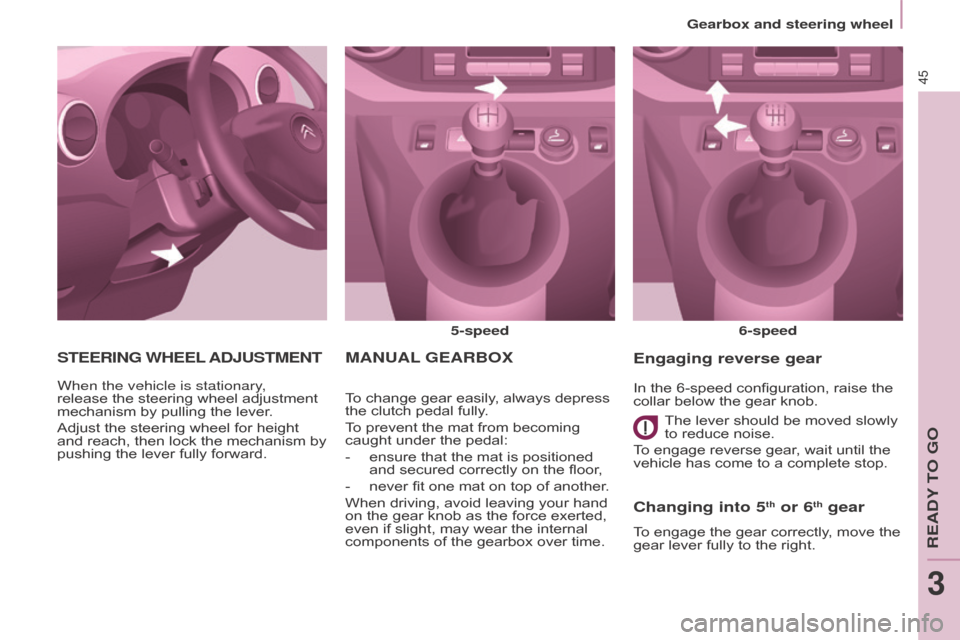
45
Berlingo2VU_en_Chap03_Pret-a-partir_ed02-2016Berlingo2VU_en_Chap03_Pret-a-partir_ed02-2016
MANUAL GEARBO x
5-speed
6-speed
To change gear easily, always depress
the clutch pedal fully.
To prevent the mat from becoming
caught under the pedal:
-
ensure that the mat is positioned
and secured correctly on the floor
,
-
never fit one mat on top of another
.
When driving, avoid leaving your hand
on the gear knob as the force exerted,
even if slight, may wear the internal
components of the gearbox over time.
Changing into 5th or 6th gear
To engage the gear correctly, move the
gear lever fully to the right. In the 6-speed configuration, raise the
collar below the gear knob.
Engaging reverse gear
S
TEERING
WHEEL
ADJUSTMENT
When the vehicle is stationary,
release the steering wheel adjustment
mechanism by pulling the lever.
Adjust the steering wheel for height
and reach, then lock the mechanism by
pushing the lever fully forward. The lever should be moved slowly
to reduce noise.
To engage reverse gear, wait until the
vehicle has come to a complete stop.
READY TO GO
3
Gearbox and steering wheel
Page 78 of 260

76
Berlingo2VU_en_Chap04_Ergonomie_ed02-2016Berlingo2VU_en_Chap04_Ergonomie_ed02-2016
Mobile office positionStorage compartment under the
seat cushion
Raise the centre seat cushion to gain
access to the storage compartment.
This space can be made secure by
fitting a padlock (not supplied).ExTENSO CAB
Centre seat
Before locking the seat in the seat
position, always take care to leave
the seat belt buckles visible and
the associated straps available for the
passengers.
This is fitted with a 3-point seat belt
with the seat belt upper anchorage on
the load retaining ladder behind the
driver.
Pull the tab located on the lower edge
of the seat to lower the seat back
incorporating a writing table equipped
with a strap.
To return the seat back to the upright
position, pull the tab and guide the seat
backrest until it locks.
During the operations, take care not to
trap the tab under the seat cushion.
Seats
Page 82 of 260
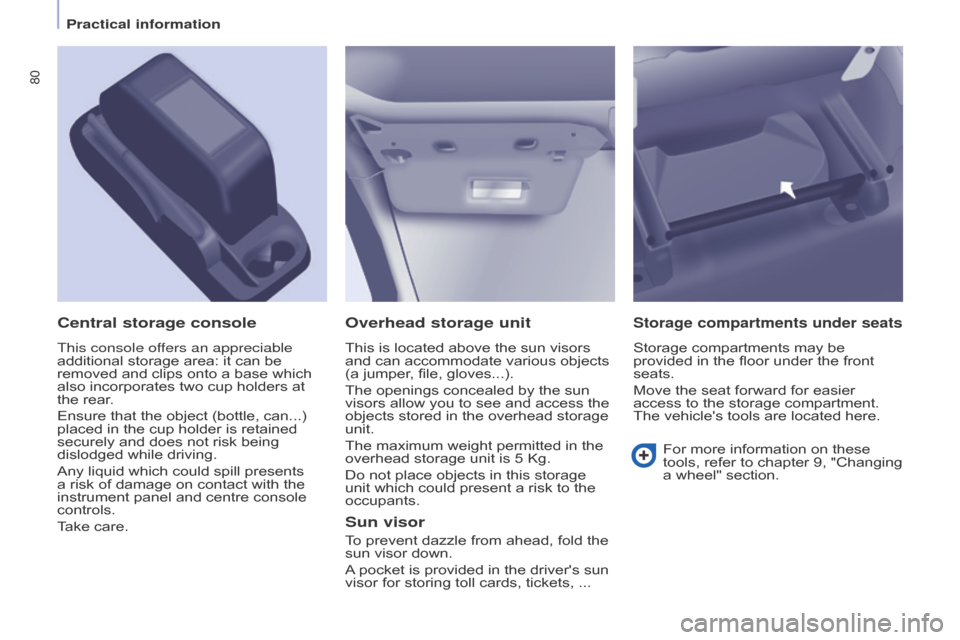
80
Berlingo2VU_en_Chap04_Ergonomie_ed02-2016Berlingo2VU_en_Chap04_Ergonomie_ed02-2016
Overhead storage unit
This is located above the sun visors
and can accommodate various objects
(a jumper, file, gloves...).
The openings concealed by the sun
visors allow you to see and access the
objects stored in the overhead storage
unit.
The maximum weight permitted in the
overhead storage unit is 5 Kg.
Do not place objects in this storage
unit which could present a risk to the
occupants.
Central storage console
This console offers an appreciable
additional storage area: it can be
removed and clips onto a base which
also incorporates two cup holders at
the rear.
Ensure that the object (bottle, can...)
placed in the cup holder is retained
securely and does not risk being
dislodged while driving.
Any liquid which could spill presents
a risk of damage on contact with the
instrument panel and centre console
controls.
Take care.
Sun visor
To prevent dazzle from ahead, fold the
sun visor down.
A pocket is provided in the driver's sun
visor for storing toll cards, tickets, ...
Storage compartments under seats
Storage compartments may be
provided in the floor under the front
seats.
Move the seat forward for easier
access to the storage compartment.
The vehicle's tools are located here.For more information on these
tools, refer to chapter 9, "Changing
a wheel" section.
Practical information
Page 85 of 260
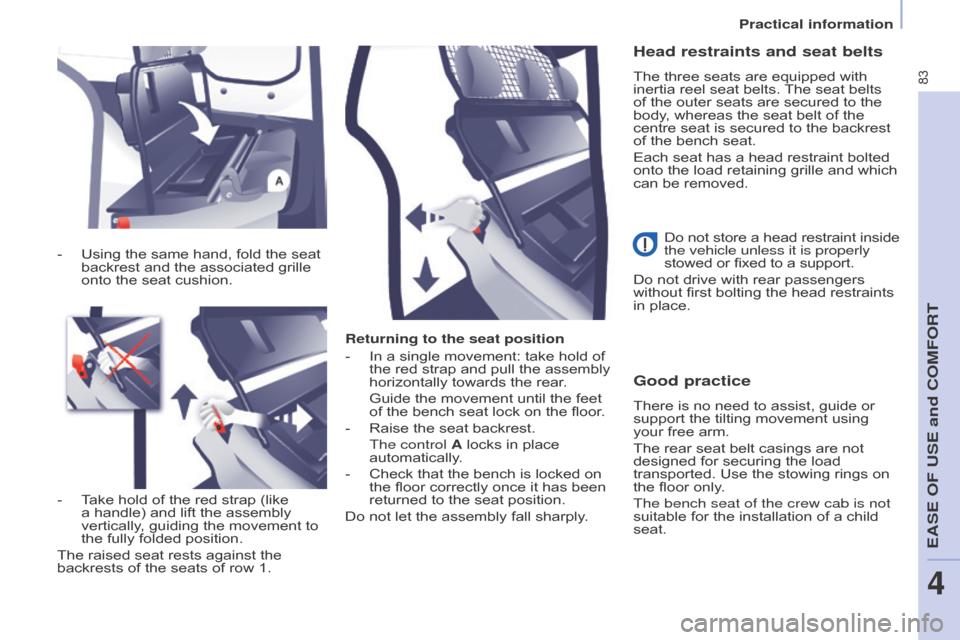
83
Berlingo2VU_en_Chap04_Ergonomie_ed02-2016Berlingo2VU_en_Chap04_Ergonomie_ed02-2016
Returning to the seat position
-
In a single movement: take hold of
the red strap and pull the assembly
horizontally towards the rear
.
Guide the movement until the feet
of the bench seat lock on the floor
.
-
Raise the seat backrest.
The control
A locks in place
automatically.
-
Check that the bench is locked on
the floor correctly once it has been
returned to the seat position.
Do not let the assembly fall sharply
.
Good practice
There is no need to assist, guide or
support the tilting movement using
your free arm.
The rear seat belt casings are not
designed for securing the load
transported. Use the stowing rings on
the floor only.
The bench seat of the crew cab is not
suitable for the installation of a child
seat.
-
Using the same hand, fold the seat
backrest and the associated grille
onto the seat cushion.
-
T
ake hold of the red strap (like
a handle) and lift the assembly
vertically, guiding the movement to
the fully folded position.
The raised seat rests against the
backrests of the seats of row 1.
Head restraints and seat belts
The three seats are equipped with
inertia reel seat belts. The seat belts
of the outer seats are secured to the
body, whereas the seat belt of the
centre seat is secured to the backrest
of the bench seat.
Each seat has a head restraint bolted
onto the load retaining grille and which
can be removed.
Do not store a head restraint inside
the vehicle unless it is properly
stowed or fixed to a support.
Do not drive with rear passengers
without first bolting the head restraints
in place.
EASE OF USE and COMFORT
4
Practical information
Page 86 of 260
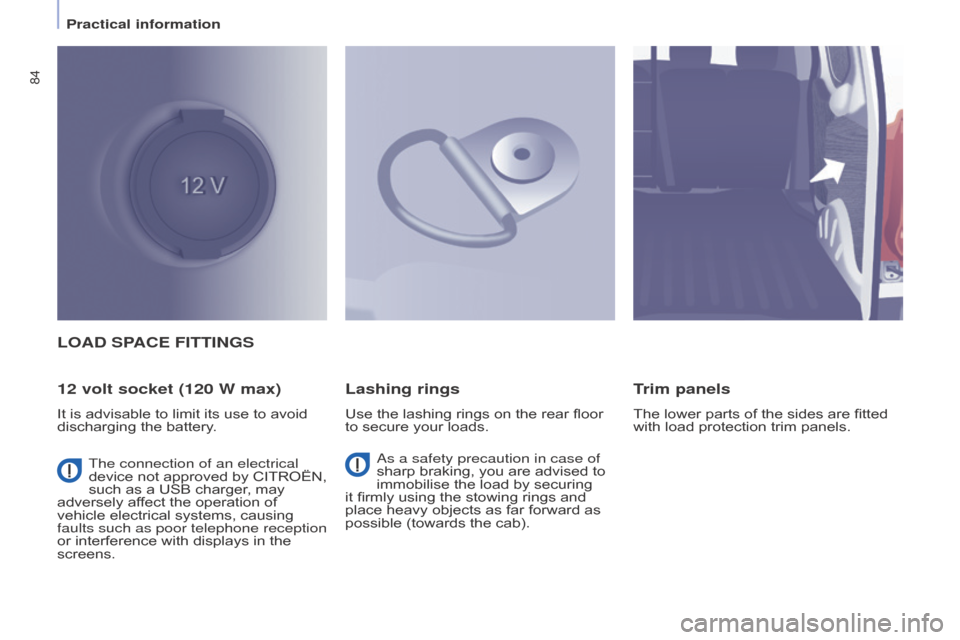
84
Berlingo2VU_en_Chap04_Ergonomie_ed02-2016Berlingo2VU_en_Chap04_Ergonomie_ed02-2016
LOAD SPACE FITTINGS
12 volt socket (120 W max)
It is advisable to limit its use to avoid
discharging the battery.
Lashing rings
Use the lashing rings on the rear floor
to secure your loads.
Trim panels
The lower parts of the sides are fitted
with load protection trim panels.
As a safety precaution in case of
sharp braking, you are advised to
immobilise the load by securing
it firmly using the stowing rings and
place heavy objects as far forward as
possible (towards the cab).
The connection of an electrical
device not approved by CITROËN,
such as a USB charger, may
adversely affect the operation of
vehicle electrical systems, causing
faults such as poor telephone reception
or interference with displays in the
screens.
Practical information
Page 88 of 260
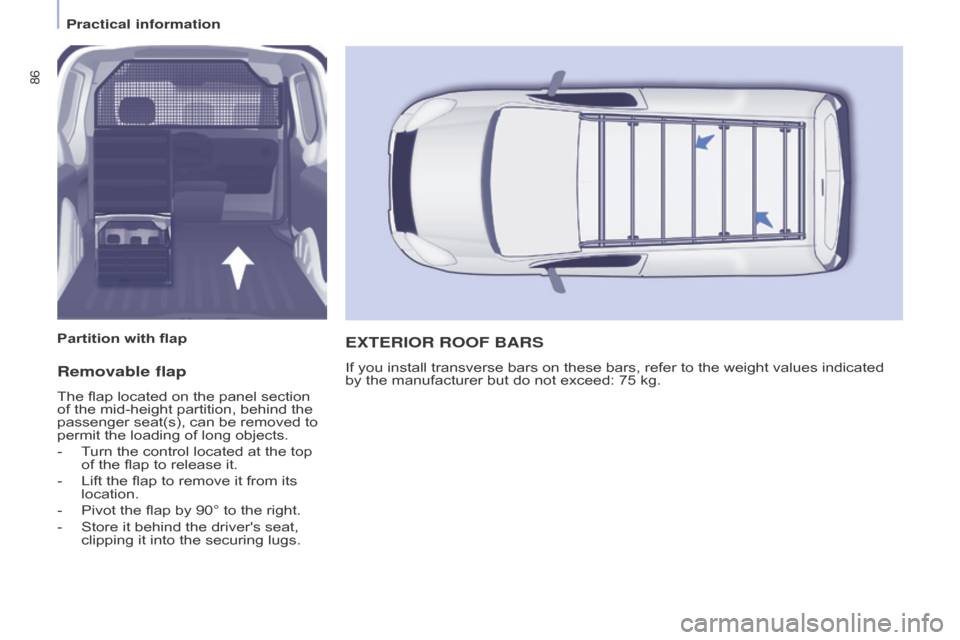
86
Berlingo2VU_en_Chap04_Ergonomie_ed02-2016Berlingo2VU_en_Chap04_Ergonomie_ed02-2016
Removable flap
The flap located on the panel section
of the mid-height partition, behind the
passenger seat(s), can be removed to
permit the loading of long objects.
-
T
urn the control located at the top
of the flap to release it.
-
Lift the flap to remove it from its
location.
-
Pivot the flap by 90° to the right.
-
Store it behind the driver's seat,
clipping it into the securing lugs.
ExTERIOR ROOF BARS
If you install transverse bars on these bars, refer to the weight values indicated
by the manufacturer but do not exceed: 75 kg.
Partition with flap
Practical information
Page 91 of 260

89
Berlingo2VU_en_Chap04_Ergonomie_ed02-2016Berlingo2VU_en_Chap04_Ergonomie_ed02-2016
ELECTRIC WINDOWS
Safety anti-pinch
When the window rises and meets an
obstacle, it stops and partially lowers. The electrical functions of the electric
windows are deactivated:
-
approximately 45 seconds after the
ignition is switched of
f,
-
after one of the front doors is
opened, if the ignition is of
f.
Manual mode
Press or pull the control, without
passing the point of resistance.
The window stops when you release
the control. This mode is available
depending on equipment; it is
identified by this symbol on the
control in question.
1.
Driver's side
2.
Passenger's side
Reinitialisation
Following reconnection of the battery,
or in the event of a malfunction, the
safety anti-pinch function must be
reinitialised.
Good practice
If the electric windows meet an
obstacle during operation, you must
reverse the movement of the window.
To do this, press the control concerned.
When the driver operates the
passenger electric window controls,
they must ensure that no one is
preventing correct closing of the
windows.
The driver must ensure that the
passengers use the electric windows
correctly.
Be aware of children when operating
the windows.
Following several consecutive closing/
opening operations of the electric
window control, a protection system
is triggered which only allows closing
of the window. After closing, wait
approximately 40 minutes. Once this
time has elapsed, the control becomes
operational again. Lower the window fully, then raise it, it
will rise in steps of a few centimetres
each time the control is pressed.
Repeat the operation until the window
is fully closed.
Continue to press the control for at
least one second after the window
closed position has been reached.
The safety anti-pinch does not operate
during these operations.
There are two operating modes:
One-touch mode
Press or pull the control, beyond the
point of resistance.
The window opens or closes fully when
the control is released.
Pressing or pulling the control again
stops the movement of the window.
EASE OF USE and COMFORT
4
Mirrors and windows
Page 92 of 260
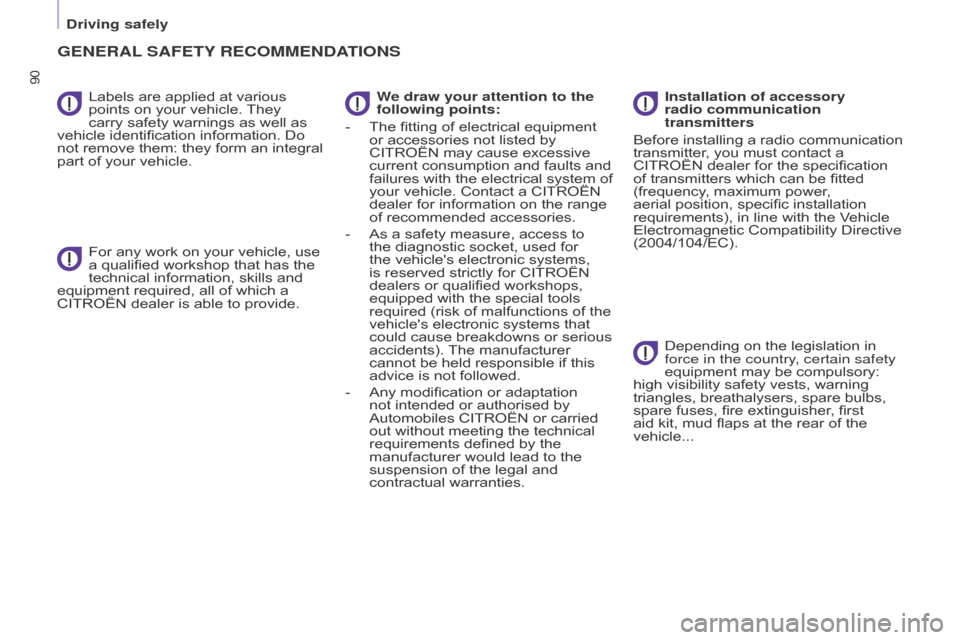
90
Berlingo2VU_en_Chap05_Securite_ed02-2016
Labels are applied at various
points on your vehicle. They
carry safety warnings as well as
vehicle identification information. Do
not remove them: they form an integral
part of your vehicle.
GENERAL SAFETY RECOMMENDATIONS
For any work on your vehicle, use
a qualified workshop that has the
technical information, skills and
equipment required, all of which a
CITROËN dealer is able to provide. We draw your attention to the
following points:
-
The fitting of electrical equipment
or accessories not listed by
CITROËN
may cause excessive
current consumption and faults and
failures with the electrical system of
your vehicle. Contact a CITROËN
dealer for information on the range
of recommended accessories.
-
As a safety measure, access to
the diagnostic socket, used for
the vehicle's electronic systems,
is reserved strictly for CITROËN
dealers or qualified workshops,
equipped with the special tools
required (risk of malfunctions of the
vehicle's electronic systems that
could cause breakdowns or serious
accidents).
The manufacturer
cannot be held responsible if this
advice is not followed.
-
Any modification or adaptation
not intended or authorised by
Automobiles CITROËN or carried
out without meeting the technical
requirements defined by the
manufacturer would lead to the
suspension of the legal and
contractual warranties. Installation of accessory
radio communication
transmitters
Before installing a radio communication
transmitter, you must contact a
CITROËN dealer for the specification
of transmitters which can be fitted
(frequency, maximum power,
aerial position, specific installation
requirements), in line with the Vehicle
Electromagnetic Compatibility Directive
(2004/104/EC).
Depending on the legislation in
force in the country, certain safety
equipment may be compulsory:
high visibility safety vests, warning
triangles, breathalysers, spare bulbs,
spare fuses, fire extinguisher, first
aid kit, mud flaps at the rear of the
vehicle...
Driving safely